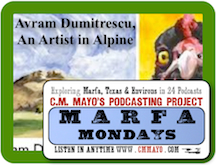|
Author of The Last Prince of the Mexican Empire, etc. |
|
|

|

|

|
|
AVRAM DUMITRESCU, AN ARTIST IN ALPINE |
|||
 |
|||
|
(APPROX 37 MINUTES) |
|||
|
|
|||
|
Announcer: Welcome to Marfa Mondays, with your host, award-winning travel writer and novelist, C.M. Mayo. [MUSIC] C.M. Mayo: Welcome to the fourth in this series of 24 podcasts exploring Marfa, Texas and environs, as part of my larger project, which is writing a travel memoir about Far West Texas. I still haven't come up with the book's title, although I have a few promising candidates. [Update: World Waiting for Dream: A Turn in Far West Texas] I'm recording this introduction in April of 2012, so if you're listening in sometime later, it's quite possible that my book not only has a title, but has been written and published. So I invite you to visit my web site, www.cmmayo.com, and read all about it. You can also read about this podcast series and Marfa, Texas at www.cmmayo.com/marfa. As I explained in the previous two podcasts in February 2012 and March 2012, my initial travels in the area have focused on the landscape, this breathtaking space, because I aim to begin the book by following the path, as far as we can guess it, of Alvar Nuñez Cabeza Vaca, the conquistador who got lost. Imagine the land without highways, without fences, telephone lines, cell phone towers, gas stations... When it comes to landscapes, painters are important people to talk to. Like all artists, they make a practice of seeing what others do not. In the previous podcast, which was posted in March of 2012, although recorded in January, I interviewed Mary Bones, the curator of a beautiful exhibition of Texas regionalist paintings at Sul Ross [State] University in Alpine, which is, by the way, about a half hour's drive from Marfa. That exhibition was "The Lost Colony," featuring works by artists who participated in the summer colony at Sul Ross that ended somewhat mysteriously in 1950. The show included paintings by Julius Woeltz, Xavier González, William Lester, and Mabel Vandiver, among many others. In the 1970s, the sculptor and painter Donald Judd arrived in Marfa and began buying up buildings in the town and ranches in the area. Judd was such a prolific, accomplished, and profoundly visionary artist that ever since artists in the area have worked in his immense shadow. It's impossible, indeed, to find any writing about the arts in the area that doesn't at least mention Judd and his works, and the two foundations, the Judd Foundation and Chinati Foundation, the latter a museum based on Judd's vision for large-scale installations in which, to quote from their web site, "art and the surrounding landscape are inextricably linked." I'm sure I'll have a lot to say about Judd and his legacy, but for now I'm getting started with the landscape per se. So I wanted to talk to someone who paints landscapes. Avram Dumitrescu's paintings were featured recently in "Marfans: Art From the Plateau" at the Nancy Fyfe Cardozier Gallery in Odessa. For his extraordinary talent and his connections with Sul Ross [State] University, I think it would be fair to say he is a direct descendant of those artists of the so-called "Lost Colony." Though some of those artists were originally from Texas, many came from afar- for example, Xavier González, who was born in Spain and studied art in Mexico City. Avram Dumitrescu grew up in Belfast, Northern Ireland. He has a fascinating story. Be sure to check out his paintings of landscapes, as well as animals, birds, automobiles, and more on his web site, www.onlineavram.com. [MUSIC] C.M. Mayo: So we're here on a chilly, bright day in Alpine, Texas in the Big Bend Arts Council's Gallery on the Square with Avram Dumitrescu. I encountered Avram's work in Cenizo Journal, and I'm always talking about Cenizo Journal, because it's just such a beautiful, elegant contribution to this whole area. I'm very impressed by this. And they had a whole piece about your watercolors, and so then I went to your website and found some really amazing landscape paintings and illustrations. Your web site says that you grew up in Belfast, Ireland, and your father was from Romania, and you met your wife in Texas, and moved out here. So, wow, that's exotic! Maybe we should start with, how did you meet your wife? Who, by the way is Megan Wilde, who— I've seen her writing also, which is on the net. She's a wonderful writer who has a lot of pieces about the Big Bend area. Avram Dumitrescu: Well, it's interesting to just realize, you know, two artists, one an artist, Megan's a journalist, so that means we're both destined for the poor house. Let's see... I'd worked at a summer camp in Belfast. I'd done one year, but really enjoyed it, and I think I was 17 or 18 at the time. And a friend, I can't remember who, had suggested, they said, "You should try doing it in America," so I applied and got accepted. And this is a pretty convoluted story, but I worked at a summer camp up in Maine, Skylemar Summer Camp. It was a lot of fun. I'd fly out for seven to eight weeks, and I'd be teaching, working with a high school art teacher there and be teaching the children just fun art projects. Because it was mostly a sports summer camp, but the art was kind of like a reprieve for some of them, and I really enjoyed it. I also did the big sets. The summer camp would put musicals on each year, so basically they were just giant illustrations, but that was a lot of fun. I did this for about, I think five or six years, maybe six years, and afterwards, I'd usually travel around with a couple friends. One year, one of the friends I was traveling with, or I wanted to meet, happened to be down in Florida, so I made my way down there, and met this blonde lady who I was very interested in but didn't really make it that apparent, because I'm not particularly good at that kind of thing. So I kept in touch with Megan, and the following summer when I did my last summer camp, I met up with her again. We started dating, and we dated trans-Atlantically for, gosh, about three years. So I'd just started a Master's in Applied Arts, and that meant I was able to save my money, took my vacation, could fly out, and just one day decided, "We should just get married." And we did, and it was very good, so I left Belfast and I've been here since the end of 2004. So it's very different from Belfast. The skies are a lot more blue out here. It doesn't rain quite as much. C.M. Mayo: That's an understatement. [LAUGHS] I think of Belfast as being very wet. Avram Dumitrescu: Yes. Well, it is pretty damp, but what's also interesting is when you just look at the grass there. It's just this verdant, verdant green, because there's so much rain. So yeah, lots of rain, and as well, because Belfast's quite a built-up city, so moving from Belfast out to Eest Texas was quite a contrast. C.M. Mayo: What prompted you to move out to here to Alpine? Avram Dumitrescu: Well, when we got married, we were living in Austin, and Megan had interned at Chinati— the Chinati Foundation— I think it was back in the late 90s, and she really… C.M. Mayo: In Marfa. Avram Dumitrescu: In Marfa. So after she worked out there, she really liked, she just had a real affinity for the place. So we moved out, gosh, I think it was a couple years later, and at first, I was a little intimidated. I thought, "It's going to be really tough," because Austin had good coffee shops, it had all kinds of box stores, movie theaters, grocery stores, and moving out to West Texas, it was a little less populated. And I thought, "How am I going to get a good cup of coffee?" But we survived, and it was actually one of the best things we did. Because it was such a small community, you got to know everybody pretty quickly, and just from my, in terms of art, my work started selling much more quickly, and I was able to develop more as an artist because I had more time to just focus on things that I wouldn't normally focus on in Austin. I think in Austin, I was doing some architecture paintings and some vehicles, and out here I discovered animals. They proved pretty popular. C.M. Mayo: Your chicken paintings, I love the chicken paintings! I am really crazy about them, because they have such- there's one that was in, it was on your web site, "Nibbs." That painting, which has sold, alas, that painting, that has the biggest personality of any chicken I have ever seen. [LAUGHS] They're really extraordinary animal paintings. Avram Dumitrescu: Well, thank you. I'm trying to remember... There was a similar magazine to the Cenizo called The Desert Candle, and I knew the owner and editor, and she'd suggested, she said, "I'd like you to do a cover." I think the theme she gave me was summer, and so I played with some ideas, and then a friend of ours in Marfa, Tigie Lancaster, has several donkeys. So I photographed them and did a nice, stormy— because you do get a lot of storms out here— landscape, and that became the cover, and was apparently really popular. So that kind of started me, I was working on animals, and let's see, donkeys and horses, and when we moved to Alpine, our landlords had about 30 chickens. Patty and Cindy, they're on the west edge of town, and great, really, really nice people, but that's where I had my first experience being around chickens, because until then it was just stuff I'd eat. They're basically mini-dinosaurs. Every time I go in, I'm always worried if I fall, and they start pecking me to death like in some horror movie because they see red, they run to it and attack it. But I'm kind of getting a little off-topic here. They're very interesting characters, and I think what really made me laugh was Patty and Cindy had named them after characters from "The Sopranos." So kind of, with their sometimes thuggish nature, especially some of the roosters, it really.. they were apt names. C.M. Mayo: [Laughs] It comes through in the paintings. Avram Dumitrescu: Yeah. They're fun to paint. C.M. Mayo: Well, you've painted a really broad variety of things, I mean, starting out with the car paintings that you did in your Master's degree in Belfast. I learned that from reading your web site, but when I look at what you've done here in West Texas, you've done all sorts of things, and your landscape paintings are also extraordinary. So I'm curious to know, who have been some of your biggest influences as an artist? Avram Dumitrescu: Let me try to answer that a different way. I mean, the reason there's a lot of varieties, boredom. If I spend too much time doing one thing, I'll get tired of it and it will show in the artwork. For every successful painting I've made, there's maybe five canvases which get painted over, at least, at least. And then I find sketching's a great way to kind of work out ideas, and it's just, it's a real thrill, and to me it's one of the best things I can do, besides eating desserts. But influences? Historically, I've always found the artist John Singer Sargent is just, he was a master of painting. I mean, when you just see how he handled light... He had this way of putting paint onto the canvas which was incredibly loose, but every shape and pushing of the paint had some meaning, and it was just… But locally, two people I always find a lot of influence from are, one of them is, there's a photographer who's sadly not doing much photography in Marfa, Chase Lindley. His wife works at the Marfa public radio station. He's just such a talented photographer, and then Mary Baxter. Her landscapes and animals are a big, big influence on me. C.M. Mayo: I have to tell you, I own two of her paintings. I just love them. One is the St. Elena Canyon, and the other one of Cathedral Mountain. Avram Dumitrescu: Those are very good acquisitions. We were really lucky when we had a baby shower, that was one of the gifts that Mary gave us, and it was, it's very treasured. But yeah, she's a big influence on me, just how she handles landscape especially. That's something I want to do more of, and I just haven't really had the opportunity. C.M. Mayo: Well, you have a new baby. That'll keep anyone from going out and working! But aside from that, this strikes me, this area strikes me as incredibly painterly. I just went over to the Lost Colony show— and now, this is a podcast, so by the time y'all are listening to this, the show will have closed, but I think the slideshow should be available on the Sul Ross [State University Museum of the Big Bend] web site. But I was really struck by that, and one of the first things I saw when I walked in was this big quote they had up on the wall by one of the students of the art colony, who said, "The Big Bend is the most paintable place I have ever worked." And that was a student named Mrs. Ruth Lovelady from 1940. Avram Dumitrescu: Mary Bones did such a good job putting that exhibition together. I know she had to contact collectors all around the States. It's such an impressive show, and I really hope your listeners can get to see the slideshow of it. I really hope that in the future, Sul Ross will be able to do something like that again, because just to have these intensive weeks and months where students would work with an artist and produce all of this wonderful work, just, it's a shame that it hasn't happened. But you know, things change, so, but hopefully in the future they'll do something like that. C.M. Mayo: Well, as a veteran of many summer writing colonies or summer writing workshops, I have to say this area has two enormous advantages, I think, and one is that it is incredibly easy and inviting and enticing. I'm not a painter, but I would love to go out and paint these landscapes. They're just breathtaking. I was driving back yesterday from Fort Davis here to Alpine at sunset, and to just watch the sun go down over those mountains, it's just so beautiful, sometimes you just want to cry. It's like an otherworldly landscape. Avram Dumitrescu: There's spectacular light out here on the landscape. I think as well, the landscape is probably more apparent because there's very few billboards. C.M. Mayo: Almost none. In fact, now that you mention it, when I was driving back on that section, that you just don't see anything. I mean, you look at this huge landscape, the entire horizon, you don't even see a tower. Now, there are some towers out there, but you can go long stretches without seeing anything but nature. Avram Dumitrescu:
Yeah, and I
think that's why, that's a big reason why it's so impressive.
But yeah, the light as well, it's a very different light. When
we were— Megan delivered our baby up in Dallas, and it was
really interesting, just how different the light was. It's 500
miles away, but I don't know if it was the elevation or the air
quality, but yep, it's a unique place. I don't know where many
places in America are like this, in that there's not much advertising.
There's not many sign posts. There's not many buildings, so it
as its appeal. Avram Dumitrescu: Spread out. That's probably the way, and let's see. My… C.M. Mayo: Well, I think we have to include Mary Baxter too, and she's out in Marathon, which is 30 miles out east. [Update: See her interview, Marfa Mondays #9, recorded in her studio in Marfa] Avram Dumitrescu: Yeah, I think Mary's lived
in Marfa. I mean, my experiences were, when we moved out here,
we happened to try to find accommodation, and the two big movies
were shooting, "There Will Be Blood" and "No Country
For Old Men." And so, there was virtually no accommodation.
We found something in Fort Davis. We had planned to live in Marfa,
because Megan was going to intern at the radio station, the Marfa public radio station.
C.M. Mayo: Well, those chickens were crazy, the Mafioso chickens. [LAUGHS] Avram Dumitrescu: I'd say Marfa's probably the... when people think of art, that Marfa is what people think of first, just because, like you've said, Donald Judd and Chinati, they've been there since, what, the 70s, and then with Judd being such an important person in the minimalist movement, has that mystique and international appeal. I mean, I remember, when we finally did live in Marfa for about a year, there would be a lot of German tourists and people from all over the world coming to see this unique style. And then what's also interesting about Marfa is, especially the main streets, there is a particular look, the minimalism's kind of spread out into the architecture. And so, you do have some galleries, you have art that mimics, that's kind of minimalist, but when it bleeds into the other areas of life, it almost... It makes it a very interesting, unique town. I think Alpine recently received a... I think it's an arts designation from the state of Texas. I'm not sure exactly of the wording, but that helped, and then there are several galleries. I actually had a studio just around the corner from here. It was a studio gallery, but I closed it just when Megan got pregnant. And what's nice is in this main street now, there's about three galleries altogether, and the majority... well, no, there's four. There's the photographer that's moved here... So it needs to be concentrated. When it's spread out a little too much, it may not feel as much of an arts community, whereas when it's, like, on one street, then it starts to get that particular vibe. C.M. Mayo: Definitely, and then people, when they come through, they can hit all the galleries, and they can see them. They're visible. There's definitely a synergy. Avram Dumitrescu: Yeah. So they... I mean, it is nice on my lunchtime, if it's raining, I can't cycle at lunchtime, I'll walk down to see what's going on in the local galleries. Personally, again, I find it a very supportive community. I think the fact that because it's small, people know what you do. You will get asked to donate paintings to things like the library board or to help raise money for the library or for the animal shelters. It's a good way to get your name out and just help people as well. So it's a small community, people know you, and I think that all helps. Because I find that a lot of art is, has a touch of fashion about it. You know, you kind of have to build up the momentum. People need to know your name, that does help sell your work. So these are kind of half-baked thoughts on a Saturday morning. I don't how much validity there is to them, but… C.M. Mayo: One of the first things anybody notices about you is your name, Dumitrescu, which is Romanian. Avram Dumitrescu: My father, he escaped from Romania when it was a Communist country in the early 1970s. My mother, she grew up in Belfast and she came from a big family. She has 12 brothers and sisters, and her mother said, "Look, go travel. Go see the world," so she went to, I think, she started off in Germany. She wanted to travel with some friends and some of her sisters. So they got to Germany, and the jobs that they were interested in weren't there because of some big strike. So they went to the Channel Islands, and they found work there, and I think they were just young, they wanted to see some of the world, grow up, especially, the 1970s in Belfast was not a... there was a lot of political trouble. C.M. Mayo: It was a really tough time. Avram Dumitrescu: Yeah. So I think that was probably one reason my mother wanted to see some of the world, you know, just have a change of tone. So my father, he played a lot of musical instruments, and he was in a Romanian folk band, and they traveled all round Europe, but I think it was, there were maybe 15, 16 band members, and around half of them were Secret Police. C.M. Mayo: Oh my goodness, making sure the other half didn't escape? Avram Dumitrescu: That was it. So my father
did, on one of the tours, he managed to sneak away when everybody
was sleeping, and he'd been talking to a restaurant owner, and
the restaurant owner had said, "Look, if you can get to
the airport, I'll fly you to the other island and we'll just
let you get away from all this." So he didn't have much
English, or I think he had very little English, and ran onto
the road and tried to find a vehicle. And all he saw, it was
like four or five in the morning, it was one of those electric
milk floats. You know, their top speed's maybe ten miles an hour.
So he finally saw this big truck going down the road, and was
able to explain to the guy by making these airplane sounds that
he was trying to get to the airport. C.M. Mayo: That's an amazing story. Avram Dumitrescu: Thank you. I just didn't want to use up all your podcast time on that. C.M. Mayo: But it's really an extraordinary story. Avram Dumitrescu: Yeah, really is. I mean, I just... it kind of contrasts with me where I just had to, I was working with the children, and met somebody through traveling, and was very pleased to meet my wife, and I'm glad I didn't have to be running from Secret Police or anything. C.M. Mayo: Well, we can so often forget what a privilege, what a luxury it is to have the freedom to make art, or to write, or to go where you please when you please, to say what you want to say. Avram Dumitrescu: That's a key thing, and that's something that kind of will bubble up in my mind so many times. It's like, especially if I'm, say, having difficulty with the painting or something, it's like, "Well, you have a roof over your head. You can eat. You've a wife that loves you, you've a baby who's wonderful. You know, people don't have electricity. People have all kinds of problems in their life," and I'm glad when I remember to be grateful about all the blessings I have in my life. C.M. Mayo: I think we all have to take a lesson from that and say the same. Oh, what a story. Thank you for sharing that. Okay, let me ask you a couple last questions here. Your favorite subjects for painting? Avram Dumitrescu: Whatever interests me at the time. I've been painting animals for quite a while. Architecture is always interesting. Vehicles can be interesting. I think things that look weathered and have a lot more personality as well. I want to do more landscapes. I really need to get back into painting figures. C.M. Mayo: What do you think you'll be painting next? I mean, if you look over the course of this year, 2012, what do you see on the horizon for yourself? Avram Dumitrescu: When I'm not cleaning up diapers?
We were in Galveston, I think, last summer, visiting family,
and I had a camera with me and I was photographing sea gulls,
so actually got two big canvases. They're ready to be painted,
of sea gulls, and I've done one. And I've been trying to loosen
up a little. So I said to her, "Look, would you mind leaving the lights on one evening," and she did, and so, I've sketched it out, and it's kind of, it's this nice kind of electric blue sky with this kind of orange, tealy light coming out of it. So after, I thought, "Well, I've wanted to try structures at night," so I then spent a couple hours photographing gas stations.... And gosh, what else? It was things that, when I was working on the photographs, it almost had an Edward Hopper quality. That's what I was trying to find. C.M. Mayo: Stark, with shadows. Avram Dumitrescu: Yeah, you get these kind of, like, one of the gas stations, just the light would leak off. It would taper to a point, and then it was just all this blackness. And I thought, "Well, this can be an interesting direction," so there was that. Alpine's also had a lot of construction going on the last year, so at my lunch time, I'd go out and sketch the construction vehicles. So that might be a series of small pieces. So night buildings, construction vehicles, and God knows what else. C.M. Mayo: That sounds interesting, and that's definitely different than the animal paintings, but it's kind of coming back to what you did earlier, about cars. You started out with a show with cars. I wanted to jump in and ask you, you're also working as a scientific illustrator for the Center for Big Bend Studies. So what do you do there? Avram Dumitrescu: I work for a team of archaeologists. It's part of Sul Ross State University, and it's all manner of visual arts. It's a very interesting job. The more basic stuff is I'll update their web site. I'll do graphic design, I'll do posters, and so on for them, but every now and again, they'll bring me in a... it's called, they call it "a point," but an arrowhead that's thousands of years old, so it's really interesting holding these small pieces of stone and drawing them. It's demanding. It's really, really tough, but it's something I never thought I'd be doing. And then I also have been teaching part-time at Sul Ross State University. I've been teaching some design classes, so that's a really, really satisfying and fulfilling job. I think that's what I had to tell myself as well when I'd done a full-time, you know, I'd go in, I'd start at eight o'clock and finish at five. I'd eat, and then teach from six to nine. So I kept having to tell myself, "Even though your eyes are going together, you really are enjoying this." But I mean, it was really, it's very interesting, and it's very rewarding teaching the students. You know, I think, I've done a lot of illustration work and fine art work and it's nice to work with some students, especially a student who may not have gone to college before, and sit down and just say, "Well, look, I'm not the best artist in the world, I don't have lots of experience, but this is what you may encounter if you follow this path." So it's been really nice sharing my experiences with local people. C.M. Mayo: This is a fantastic interview. I thank you so much for giving me your time. [MUSIC] Announcer: Tune in for Marfa Mondays with your host, C.M. Mayo, at cmmayo.com/podcasts. [MUSIC] |
|||
|
|
|||
|
|||

|

